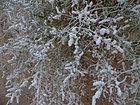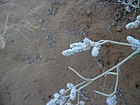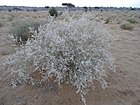Note: This is a project under development. The articles on this wiki are just being initiated and broadly incomplete. You can Help creating new pages.
Difference between revisions of "Aerva javanica - Snow bush"
(→Chemical Composition) |
|||
| (9 intermediate revisions by 2 users not shown) | |||
| Line 1: | Line 1: | ||
[[File:Aerva tomentosa.JPG|thumb|right|''Buee'', ''Aerva javanica'']] | [[File:Aerva tomentosa.JPG|thumb|right|''Buee'', ''Aerva javanica'']] | ||
| − | '''Aerva javanica''' is a species of plant in the Amaranthaceae family. It has a native distribution incorporating much of Africa | + | '''Aerva javanica''' is a species of plant in the Amaranthaceae family. It has a native distribution incorporating much of Africa and the south-west and south of Asia. |
| − | |||
==Uses== | ==Uses== | ||
| − | {{Uses|Rheumatism}}, {{Uses|Cracking of skin}}, {{Uses|Hemorrhoids}}, {{Uses|Skin dryness}}, {{Uses|Skin eruptions}}, | + | {{Uses|Rheumatism}}, {{Uses|Cracking of skin}}, {{Uses|Hemorrhoids}}, {{Uses|Skin dryness}}, {{Uses|Skin eruptions}}, {{Uses|Fever}}, {{Uses|Vomiting}}.<ref name="Uses"/> |
==Parts Used== | ==Parts Used== | ||
| Line 9: | Line 8: | ||
==Chemical Composition== | ==Chemical Composition== | ||
| − | The plant extract contains ascorbic acid, kaempferol, beta-amyrin and beta-sitosterol. The leaves also contain sitosterol and its glucoside. <ref name="chemical composition"/> | + | The plant extract contains ascorbic acid, kaempferol, beta-amyrin and beta-sitosterol. The leaves also contain sitosterol and its glucoside.<ref name="chemical composition"/> |
==Common names== | ==Common names== | ||
| − | {{Common names|kn=|ml=|sa=Dholphuli, Khul|ta=Perumpoolai|te=|hi= | + | {{Common names|kn=ದೊಡ್ಡ ಹಿಂಡಿ ಗಿಡ Dodda hindi gida|ml=|mr=Khul|sa=Dholphuli, Khul|ta=Perumpoolai|te=Magabira|hi=Safed bui|en=Javanese Wool Plant, Kapok Bush, Snow bush}}<ref name="Common names"/> |
==Properties== | ==Properties== | ||
| Line 39: | Line 38: | ||
===Flower=== | ===Flower=== | ||
| − | {{Flower| | + | {{Flower|Bisexual|Up to 10 cm long and 10 mm wide|Whitish flowers||Separate male and female flowers are borne on separate plants and Its flowering season is May-October}} |
===Fruit=== | ===Fruit=== | ||
| − | {{Fruit| | + | {{Fruit|Utricle|1-1.5 mm long||Orbicular|Many|Fruiting season is May-October}} |
===Other features=== | ===Other features=== | ||
| Line 64: | Line 63: | ||
<gallery class="left" caption="" widths="140px" heights="140px"> | <gallery class="left" caption="" widths="140px" heights="140px"> | ||
Aerva javanica - Habitat shot.jpg | Aerva javanica - Habitat shot.jpg | ||
| − | |||
| − | |||
Aerva javanica 01.jpg | Aerva javanica 01.jpg | ||
File:الارى.jpg|Leaves | File:الارى.jpg|Leaves | ||
| − | |||
Aerva javanica 02.jpg | Aerva javanica 02.jpg | ||
| − | |||
| − | |||
Aerva javanica 03.jpg|Fruiting spikes | Aerva javanica 03.jpg|Fruiting spikes | ||
| − | |||
| − | |||
Aerva javanica 04.jpg | Aerva javanica 04.jpg | ||
| − | |||
| − | |||
Aerva javanica Pilbara.jpg | Aerva javanica Pilbara.jpg | ||
| − | |||
| − | |||
Aerva javanica-1-dk-yercaud-salem-India.JPG | Aerva javanica-1-dk-yercaud-salem-India.JPG | ||
| − | |||
| − | |||
Aerva javanica-2-dk-yercaud-salem-India.JPG | Aerva javanica-2-dk-yercaud-salem-India.JPG | ||
| − | |||
</gallery> | </gallery> | ||
==References== | ==References== | ||
| − | |||
<references> | <references> | ||
| − | <ref name="chemical composition">[ | + | <ref name="chemical composition">[http://gbpihedenvis.nic.in/PDFs/Glossary_Medicinal_Plants_Springer.pdf Chemical constituents]</ref> |
| − | <ref name="Leaf">[https://keyserver.lucidcentral.org/weeds/data/media/Html/aerva_javanica.htm | + | <ref name="Leaf">[https://keyserver.lucidcentral.org/weeds/data/media/Html/aerva_javanica.htm Stems and Leaves]</ref> |
| − | <ref name="Ayurvedic preparations">[https://easyayurveda.com/2017/03/29/gorakshaganja-aerva-lanata/ | + | <ref name="Ayurvedic preparations">[https://easyayurveda.com/2017/03/29/gorakshaganja-aerva-lanata/ Ayurvedic Preparation]</ref> |
| − | <ref name="How to plant/cultivate">[http://tropical.theferns.info/viewtropical.php?id=Aerva+javanica | + | <ref name="How to plant/cultivate">[http://tropical.theferns.info/viewtropical.php?id=Aerva+javanica Cultivation Details]</ref> |
| + | <ref name="Common names">[https://sites.google.com/site/indiannamesofplants/via-species/a/aerva-javanica Common names]</ref> | ||
| + | <ref name="Uses">Kappathagudda - A Repertoire of Medicinal Plants of Gadag, Page no: 46</ref> | ||
</references> | </references> | ||
| Line 104: | Line 90: | ||
[[Category:Herbs]] | [[Category:Herbs]] | ||
[[Category:Amaranthaceae]] | [[Category:Amaranthaceae]] | ||
| + | [[Category:Pages without herbs images]] | ||
Latest revision as of 17:02, 2 February 2021
Aerva javanica is a species of plant in the Amaranthaceae family. It has a native distribution incorporating much of Africa and the south-west and south of Asia.
Contents
- 1 Uses
- 2 Parts Used
- 3 Chemical Composition
- 4 Common names
- 5 Properties
- 6 Habit
- 7 Identification
- 8 List of Ayurvedic medicine in which the herb is used
- 9 Where to get the saplings
- 10 Mode of Propagation
- 11 How to plant/cultivate
- 12 Commonly seen growing in areas
- 13 Photo Gallery
- 14 References
- 15 External Links
Uses
Rheumatism, Cracking of skin, Hemorrhoids, Skin dryness, Skin eruptions, Fever, Vomiting.[1]
Parts Used
Chemical Composition
The plant extract contains ascorbic acid, kaempferol, beta-amyrin and beta-sitosterol. The leaves also contain sitosterol and its glucoside.[2]
Common names
| Language | Common name |
|---|---|
| Kannada | ದೊಡ್ಡ ಹಿಂಡಿ ಗಿಡ Dodda hindi gida |
| Hindi | Safed bui |
| Malayalam | |
| Tamil | Perumpoolai |
| Telugu | Magabira |
| Marathi | Khul |
| Gujarathi | NA |
| Punjabi | NA |
| Kashmiri | NA |
| Sanskrit | Dholphuli, Khul |
| English | Javanese Wool Plant, Kapok Bush, Snow bush |
Properties
Reference: Dravya - Substance, Rasa - Taste, Guna - Qualities, Veerya - Potency, Vipaka - Post-digesion effect, Karma - Pharmacological activity, Prabhava - Therepeutics.
Dravya
Rasa
Tikta (Bitter), Kashaya (Astringent)
Guna
Laghu (Light), Tikshna (Sharp)
Veerya
Ushna (Hot)
Vipaka
Katu (Pungent)
Karma
Kapha, vata shamaka
Prabhava
Habit
Identification
Leaf
| Kind | Shape | Feature |
|---|---|---|
| Simple | 2-7 cm long | leaves are alternately arranged along the stems and are quite variable in shape |
Flower
| Type | Size | Color and composition | Stamen | More information |
|---|---|---|---|---|
| Bisexual | Up to 10 cm long and 10 mm wide | Whitish flowers | Separate male and female flowers are borne on separate plants and Its flowering season is May-October |
Fruit
| Type | Size | Mass | Appearance | Seeds | More information |
|---|---|---|---|---|---|
| Utricle | 1-1.5 mm long | Orbicular | Many | Fruiting season is May-October |
Other features
List of Ayurvedic medicine in which the herb is used
Where to get the saplings
Mode of Propagation
How to plant/cultivate
A plant of drier areas in the tropics and subtropics where it is found at elevations from sea level to 1,900 metres[6]
Commonly seen growing in areas
African forest, Tropical areas.
Photo Gallery
References
- ↑ Kappathagudda - A Repertoire of Medicinal Plants of Gadag, Page no: 46
- ↑ Chemical constituents
- ↑ Common names
- ↑ Stems and Leaves
- ↑ Ayurvedic Preparation
- ↑ Cultivation Details
External Links
- Ayurvedic Herbs known to be helpful to treat Rheumatism
- Ayurvedic Herbs known to be helpful to treat Cracking of skin
- Ayurvedic Herbs known to be helpful to treat Hemorrhoids
- Ayurvedic Herbs known to be helpful to treat Skin dryness
- Ayurvedic Herbs known to be helpful to treat Skin eruptions
- Ayurvedic Herbs known to be helpful to treat Fever
- Ayurvedic Herbs known to be helpful to treat Vomiting
- Herbs with Roots used in medicine
- Herbs with Woolly spikes used in medicine
- Herbs with common name in Kannada
- Herbs with common name in Hindi
- Herbs with common name in Tamil
- Herbs with common name in Telugu
- Herbs with common name in Marathi
- Herbs with common name in Sanskrit
- Herbs with common name in English
- Habit - Perennial herb
- Index of Plants which can be propagated by Seeds
- Herbs that are commonly seen in the region of African forest
- Herbs that are commonly seen in the region of Tropical areas
- Herbs
- Amaranthaceae
- Pages without herbs images









